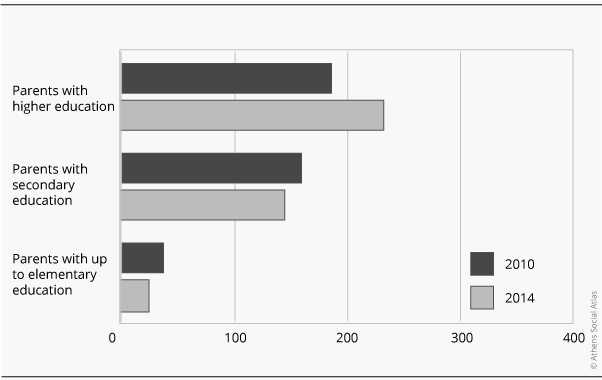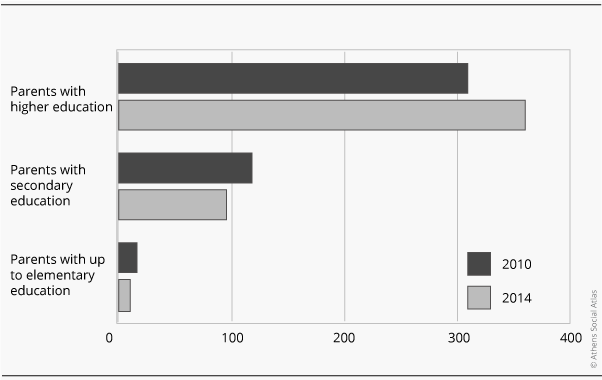The reproduction of inequality through education in the times of crisis
Maloutas Thomas
Education, Social Structure
2016 | Jan
Whether the dominant perception within a specific social context considers social inequality as a social justice problem relates to class hegemony. When the dominated accept their socially subordinate position, they usually accept it also as the natural order of things, if not as a fair settlement of what one can expect from one’s life.
For liberal and neo-liberal ideas prevailing in the last decades, inequality is not an issue. As people are considered inherently unequal, the conditions of inequality under which they eventually live are considered a normally expected outcome. Accepting inequality as a normal state of affairs is also combined with the view that social progress is the result of individual progress, which occurs through competition. Thus, it is a prevailing perception that the common interest is served by society’s support of the strongest players (students, businessmen, sportsmen …) the individual progress of whom is supposed to gradually trickle down the whole social body. The most progressive forms of liberalism accept that inequality is in fact a social justice issue and try to address it by providing “equal opportunities”. Equal opportunities, however, systematically lead to unequal results when offered to people that are inherently unequal. The dominance of neoliberal ideas has reduced sensitivity to social equity including the mere reference to social justice issues, even in the relatively ambivalent form of equal opportunities.
The economic and social policies pursued in recent decades have caused inequalities to vastly spread, bringing them progressively to the foreground as a social justice issue. Within the framework of neoliberal ideological domination, however, large and spreading inequalities become mainly the target for those who see them as a factor limiting prospects for growth (Guélaud 2015; Ostry et al. 2016).
During the years of the crisis in Greece, income inequality has grown. Between 2009 and 2014, the 80/20 index (i.e. the ratio of the income of those at the highest 20% compared to those at the lowest 20% of the relevant scale) has risen from 5.8 to 6.5 times and the Gini ratio of unequal distribution from 33.1 to 34.5 (ΕΛΣΤΑΤ 2015).
The broadening of inequalities in education is less noticeable. Here, the issues that prevail in the social and political agenda are those sensitising mainly middle class households that support education in the hope that their children will manage to keep at least the same social status. Thus, issues such as the absorption of university graduates –even from “select” Faculties with postgraduate studies– in the long-suffering labour market have been greatly highlighted. In this context, highlighting the issue of “brain drain” is not only related to the undeniable importance of the issue for the Greek economy, but also to the social groups mainly affected by this development. When, in the 90s, lower class groups were losing a significant part of their access –through higher education degrees– mainly to public employment, the problem received little attention in the social and political agenda.
Social inequality –and its growth– as regards access to education continues to be rather overlooked to this day and consequently it is not addressed as a key issue to be resolved. This is partially due to the fact that this inequality is not easily documented, since it is mainly incribed in the outcome of the examinations for admission to higher education, and is largely perceived as related to personal merit. In other countries –like in Germany, for example– educational trajectories are socially separated in a more distinct way and at a much earlier age (Maloutas & Ramos-Lobato 2015).
In Greece, the blatantly privileged education trajectories concern a relatively small percentage of pupils in elite private schools and in certain experimental public schools, followed by studies at renowned universities of a small number of foreign countries. At the other end, the most unfavoured courses, which end quickly (by dropping out) or are completely ineffective (illiteracy) are also of relatively small size and mostly concern socially excluded groups, such as the Roma.
The vast majority of pupils is educated in comprehensive public schools, while access to higher education depends mainly on the performance following uniform and transparent entry examinations. Thus, it is believed that this is an equal opportunity process for the vast majority of pupils, if one sets aside the socially unequal opportunities for preparing for the entry examinations (Sianou-Kyrgiou 2008).
Had there been a minimum of equal opportunities, the social origin of students in all Higher education Schools and Departments would be quite similar to the distribution of social groups within the overall population. This, however, is not the case. Instead, the data on the educational level of students’ parents in all University Departments according to the Hellenic Statistical Authority (ΕΛΣΤΑΤ 2014) show that social origin does seem to play a very important role, which further intensified during the crisis.
Figure 1 shows that candidates whose parents were higher education graduates in 2010 had almost double the chances of attending Universities compared to the average candidate and that in 2014 this gap increased from 1.9 to 2.3 times [1]. These chances become even more unequal when it comes to attendance at “elite” University departments (Figure 2): 3.1 times more than the average candidate for 2010, increased to 3.6 times in 2014. Inequality is catalytic when it comes to the chances of those whose parents are university graduates compared to those with secondary school-educated parents, at best: Five times more chances of admission to Universities in 2010 which increased to 8.6 times in 2014 and 17.7 times more for admission to “elite” schools in 2010, which increased to 29.5 times in 2014.
Figure 1: Chances of attending University according to parents’ educational level (candidate average chances = 100)
Figure 2: Chances of attending an “elite” University department [2] according to parents’ educational level (candidate average chances = 100)
It is well known that education does not merely train new generations. It also creates a hierarchy of their members based on their performance, creating unequal social mobility prospects. This hierarchy largely reproduces class hierarchies and other discriminations of past generations. The importance of educational qualifications becomes less significant at a time when they become accessible to an ever increasing number of young people, while on the contrary, the importance of the accumulated economic and social capital increases. However, the sorting caused by education is still an extremely important factor for the prospects of social mobility in the largest part of new generations.
Within these conditions, the school’s role should be to reduce social inequalities and discrimination. However, this has been sidelined by neoliberal ideas and policies. Unequal educational trajectories are shaped by social inequality and further reinforce it. Despite it being relatively difficult to perceive as such, unequal social access to higher education is a crucial issue of social justice that should be addressed along with the many other problems that have accumulated at all educational levels and have deteriorated during the crisis.
[1] The probabilities were calculated by comparing the rates of three groups of students –based on the level of their parents’ education– in the whole student population with those of the same education level groups of potential student parents (40-75 years) in the general population.
[2] An approximate number of 20 University departments were indicatively considered as “elite” schools (from a total of 262) where the parents of students had the highest education level based on 2014 data (minimal changes in the relevant grouping arise when 2010 data are used). As a matter of principle, these Departments generally require the highest entry scores.
They are the following:
- University of Athens (Legal, Medical, Dental, Pharmaceutical)
- Aristotle University of Thessaloniki (Architecture, Medicine, Veterinary Medicine, Dentistry, Pharmacy, Civil Engineering)
- University of Thessaly (Architecture)
- Demokrition University of Thrace (Medicine)
- University of Ioannina (Medicine)
- University of Crete (Medicine)
- University of Patras (Medicine, Pharmacy, Architecture, Electrical engineering, IT)
- National Technical University of Athens (Mechanical Engineering, Electrical Engineering, IT, Shipping)
Entry citation
Maloutas, T. (2016) The reproduction of inequality through education in the times of crisis, in Maloutas T., Spyrellis S. (eds) Athens Social Atlas. Digital compendium of texts and visual material. URL: https://www.athenssocialatlas.gr/en/article/unequal-access-to-education/ , DOI: 10.17902/20971.59
Atlas citation
Maloutas T., Spyrellis S. (eds) (2015) Athens Social Atlas. Digital compendium of texts and visual material. URL: https://www.athenssocialatlas.gr/en/ , DOI: 10.17902/20971.9
References
- ΕΛΣΤΑΤ (2015) Δελτίο τύπου. Οικονομική ανισότητα. Available from: http://www.statistics.gr/documents/20181/985119/??????????+?????????/43a8823f-ee2f-4d6b-ba22-376f71c39eb8?version=1.0.
- ΕΛΣΤΑΤ (2014) Φοιτητές κατά Επίπεδο Εκπαίδευσης των γονέων τους. Available from: http://www.statistics.gr/el/statistics/-/publication/SED34/2014.
- Sianou Kyrgiou E (2008) Social class and access to higher education in Greece: Supportive preparation lessons and success in national exams. International Studies in Sociology of Education, Taylor & Francis 18(3–4): 173–183. Available from: http://www.tandfonline.com/doi/abs/10.1080/09620210802492757.
- Maloutas T and Lobato IR (2015) Education and social reproduction: Educational mechanisms and residential segregation in Athens and Dortmund. Local Economy, SAGE Publications 30(7): 800–817.
- Guélaud C (2015) Les inégalités de revenus nuisent à la croissance. Le Monde, Paris.
- Ostry JD, Loungani P and Furceri D (2016) Neoliberalism: Oversold. Finance & Development 53(4): 38–41.


